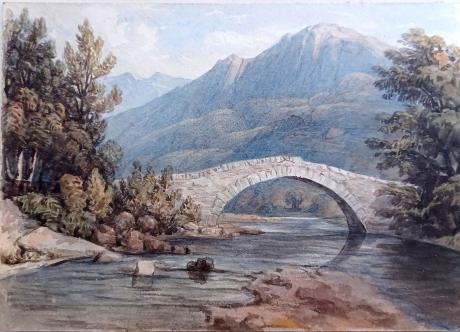page from an album inscribed in the frontispage "F W Staines 3 Uplands St Leonards on Sea"
Amelia Jackson, Nee Staines (1842 – 1925) and thence by descent
Brig o' Turk is a small rural village historically in Perthshire and today within the council area of Stirling, Scotland. It is situated in the Trossachs, a range of hills on the A821 road. The settlement probably first grew around a ford over the Finglas Water. A wooden bridge was built in the 1700s, which was replaced by the stone bridge you see today in the early 1800s. The unusual name of the village comes partly, and obviously, from the location of a bridge here. The "Turk" element comes from the Gaelic tuirc, which means wild boar, and suggests they were once hunted here.
Brig o' Turk has a rare 1930s wooden tea room, which featured in the 1959 remake of The 39 Steps. Brig o' Turk also features a village hall which hosts many craft fairs, dances and other events, a small primary school (Trossachs Primary of 1875) serving the village and the surrounding areas, a small post office (located in someone's house) and a pub-restaurant, called The Byre Inn, which is made to look like the cow barn attached to the large neighbouring house, Dundarroch. The Bicycle Tree, located half a mile north of the village, is a local landmark and tourist attraction.
The Church of Scotland parish church, called the Trossachs Parish Church, is located to the west of the village overlooking Loch Achray. It was built in 1849 in the early Gothic style, to cater for tourists visiting the area. It contains a memorial plaque to Major-General David Limond C.B. (1831–1895), a veteran of the Siege of Lucknow in the Indian Mutiny. The church, together with the graveyard and boundary wall, is a Category C(S) listed building.
The village is named after the Brig o'Turk bridge over the River Turk. The bridge was built in 1796 and lies to the west of the village, although bridges have crossed the river since 1451.
In 1708, Brig o' Turk was the venue for a gathering of prominent Jacobite lairds in support of the expected invasion by James Stuart, the "Old Pretender". In the event, the commander of the French fleet of 30 ships carrying James's 6,000-strong force withdrew rather than risk an action with the Royal Navy; however, the gathering later was used as evidence of treason against the participants.
In the mid nineteenth century the village was the location of a famous Victorian love triangle involving John Ruskin, his wife Effie Gray, and protégé John Everett Millais.
There are a number of community groups based in the area such as the Trossachs Welfare association, Trossachs Community Council and Trossachs Community Trust.
Francis William Staines was the last of a family of merchants from the City of London. Not only was he a successful businessman but he possessed a large independent fortune, such that he could devote his time to the cultivation of his talents in music and art. He was a brilliant amateur violinist, and also loved to spend much of his time painting. His daughter Amelia and her mother accompanied Mr Staines as he travelled throughout the country finding subjects for his painting. One area of the country that they visited frequently was Scotland and the Lake District, and Amelia grew particularly fond of the dramatic landscape of the Fells. Skelwith Bridge with the view of the hills around it 43 was one of her father’s favourite scenes. He painted landscapes and maritime paintings , exhibited 11 works at the RA including views on the Italian Coast, address in London, Hastings and St Leonards on Sea Susssex.

